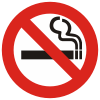
Smoking in Colombia was banned in May 2008 in public transport vehicles, hospitals, kindergartens and schools, bars, clubs, restaurants, business centers and airports. [1] Smoking areas in enclosed public places were also banned. [1]

Smoking in Colombia was banned in May 2008 in public transport vehicles, hospitals, kindergartens and schools, bars, clubs, restaurants, business centers and airports. [1] Smoking areas in enclosed public places were also banned. [1]
There are over 5 million smokers in Colombia. Teenage smokers account for nearly a third of smokers, and their numbers continue to rise. [2] The ministry of social security and health reported that diseases related to smoking killed an average of 68 Colombians per day before the implementation of the ban. [2]

Smoking bans, or smoke-free laws, are public policies, including criminal laws and occupational safety and health regulations, that prohibit tobacco smoking in certain spaces. The spaces most commonly affected by smoking bans are indoor workplaces and buildings open to the public such as restaurants, bars, office buildings, schools, retail stores, hospitals, libraries, transport facilities, and government buildings, in addition to public transport vehicles such as aircraft, buses, watercraft, and trains. However, laws may also prohibit smoking in outdoor areas such as parks, beaches, pedestrian plazas, college and hospital campuses, and within a certain distance from the entrance to a building, and in some cases, private vehicles and multi-unit residences.

Tobacco products, especially when smoked or used orally, have negative effects on human health, and concerns about these effects have existed for a long time. Research has focused primarily on cigarette smoking.
Smokeasy is a term which came briefly into use in the wake of government-imposed smoking bans in businesses. It refers to bars and other venues that encourage evasion of the ban. The term has also been used to describe locations and events promoted by tobacco companies to avoid or evade bans on smoking. The word was added to the New Oxford American Dictionary in 2005, although it was used as early as 1978. It is a portmanteau of smoking and speakeasy. As smoking bans have become generally accepted, the term has fallen into disuse.

Prevalence of tobacco use is reported by the World Health Organization (WHO), which focuses on cigarette smoking due to reported data limitations. Smoking has therefore been studied more extensively than any other form of consumption.
The loi Évin is the French alcohol and tobacco policy law passed in 1991. It takes its name from Claude Évin, then Minister of Health, who proposed it to Parliament.

A menthol cigarette is a cigarette flavored with the compound menthol.

Smoking in Japan is practiced by around 20,000,000 people, and the nation is one of the world's largest tobacco markets, though tobacco use has been declining in recent years.

Tobacco politics refers to the politics surrounding the use and distribution of tobacco.
Smoking bans in private vehicles are enacted to protect passengers from secondhand smoke and to increase road traffic safety, e.g. by preventing the driver from being distracted by the act of smoking. Smoking bans in private vehicles are less common than bans extended to public transport or vehicles used during work, like trucks or police cars.
Smoking in China is prevalent, as the People's Republic of China is the world's largest consumer and producer of tobacco: there are 350 million Chinese smokers, and China produces 42% of the world's cigarettes. The China National Tobacco Corporation is by sales the largest single manufacturer of tobacco products in the world and boasts a monopoly in Mainland China generating between 7 and 10% of government revenue. Within the Chinese guanxi system, tobacco is still a ubiquitous gift acceptable on any occasion, particularly outside urban areas. Tobacco control exists as smoking bans, but public enforcement is rare outside the most highly internationalized cities, such as Shanghai and Beijing. Furthermore, outside the largest cities in China, smoking is considered socially acceptable anywhere at any time, even if it is technically illegal.
The majority of lifelong smokers begin smoking habits before the age of 24, which makes the college years a critical time for tobacco companies to convince college students to pick up the habit of cigarette smoking. Cigarette smoking in college is seen as a social activity by those who partake in it, and more than half of the students that are users do not consider themselves smokers. This may be because most college students plan to quit smoking by the time that they graduate.

Smoking in Singapore is subjected to restrictions enacted through various legislations such as the Smoking Act, which was first enacted in 1970.

Smoking in Syria is steadily increasing in popularity amongst the Syrian population, mainly in the forms of cigarettes or narghiles. In Syria, the General Organization of Tobacco manages the growth and exportation of tobacco products. Syrians collectively spend about $600 million per year on tobacco consumption. As of 2010, 20% of women and 60% of men smoke and 98% of the overall population is affected by passive smoking. Narghiles and cigarettes are the two main forms of tobacco consumption. Despite the assumption that smoking, specifically the narghile, is embedded in Syrian culture, this phenomenon has only recently become widespread. Health officials are currently working on smoking cessation programs and policies, to remove this idea that smoking in Syria is an essential part of the culture, to educate regarding health effects, and to prevent citizens from smoking in public places.

SmokinginCanada is banned in indoor public spaces, public transit facilities and workplaces, by all territories and provinces, and by the federal government. As of 2010, legislation banning smoking within each of these jurisdictions is mostly consistent, despite the separate development of legislation by each jurisdiction. Notable variations between the jurisdictions include: whether, and in what circumstances ventilated smoking rooms are permitted; whether, and up to what distance away from a building is smoking banned outside of a building; and, whether smoking is banned in private vehicles occupied by children.
Smoking in Malaysia was first dealt with in legislation requiring a general warning message on all Malaysian cigarette packaging in 1976. Smoking bans in public places started to be implemented in the 1980s. Selling of cigarettes to persons under the age of 18 has been forbidden since May 14, 1994. Tobacco advertising was outlawed in 2003; since January 1995, showing cigarette packaging in advertisements had been forbidden, and print media advertising had been restricted to only one page.

There are approximately 57 million smokers in Indonesia, among a population of 273 million people. Around 63% of men and 5% of women report smoking, equating to 34% of the population. The majority, 88% of Indonesian smokers, use clove-flavoured kreteks. Kretek manufacturers directly employ over 180,000 people in Indonesia and an additional 10 million indirectly. Indonesia is the fifth largest tobacco market in the world, and in 2008 over 165 billion cigarettes were sold in the country.
Smoking in South Korea has decreased overall for both men and women in the past decades. However, a high prevalence of tobacco use is still observed, especially with the rise of novel tobacco products like e-cigarettes and heat-not-burn tobacco products. There are socioeconomic inequalities in smoking prevalence according to gender, income, education, and occupational class. Advocates call for measures to reduce the smoking rates and address smoking inequalities using a combination of monitoring and tobacco control policies. These measures include significant price hikes, mandatory warning photos on cigarette packs, advertising bans, financial incentives, medical help for quitting, and complete smoking bans in public places.

Smoking in Greece was at the highest rate of tobacco consumption in the European Union in 2010. In 2014, Greece had the highest rate of smoking in the European Union. According to a survey published by the European Commission Day for World No Tobacco Day in 2017, 37% of Greeks are smokers and only 44% of Greeks have never smoked a cigarette, the smallest percentage in the EU. After Greece, France and Bulgaria have the next largest number of smokers with 36%. At 7%, Sweden had the lowest rate.

Tobacco policy in Armenia is the attempt by the Armenian authorities to regulate smoking in Armenia. Tobacco laws and regulations are controlled by the Ministry of Health of Armenia. Armenian men tend to be the most common tobacco users, as 42.5% of men over the age of 15 smoke.